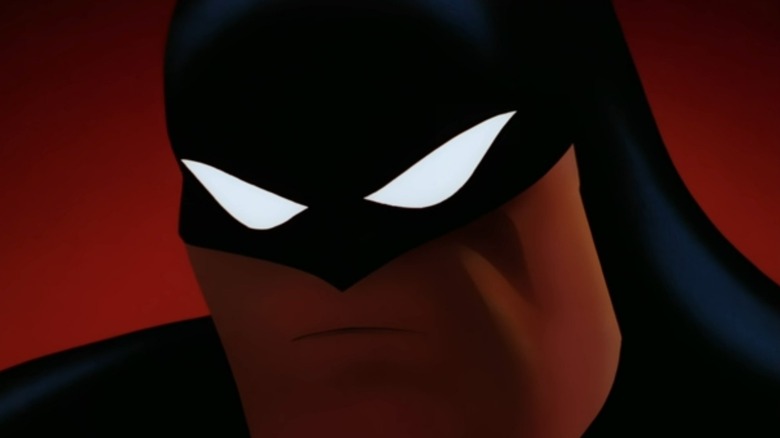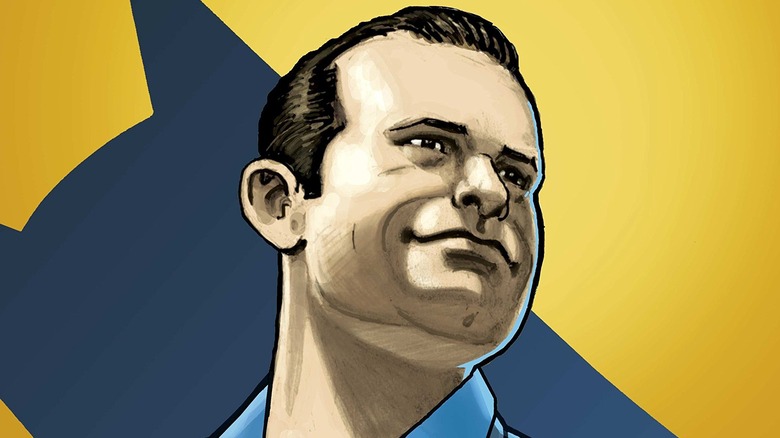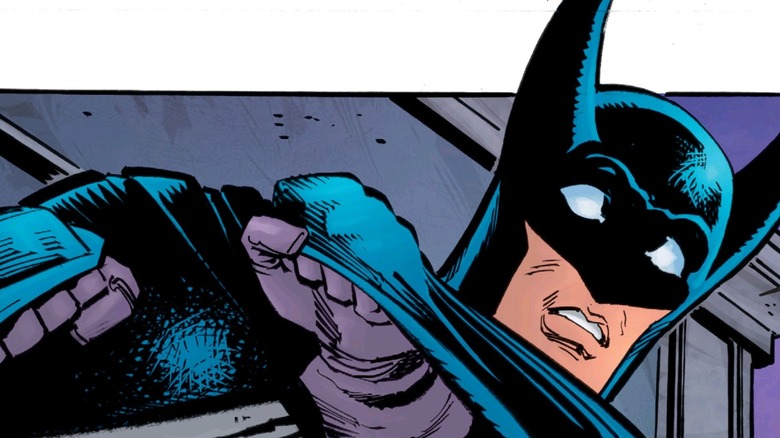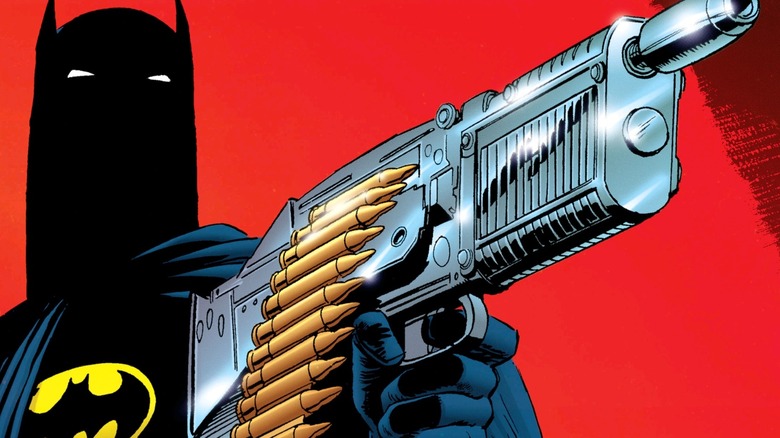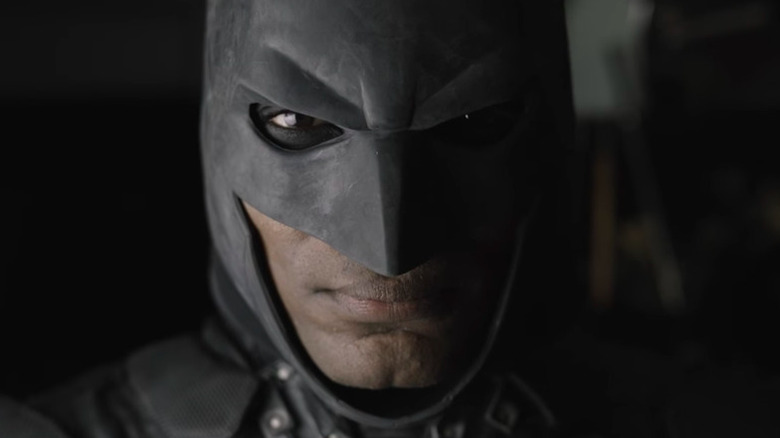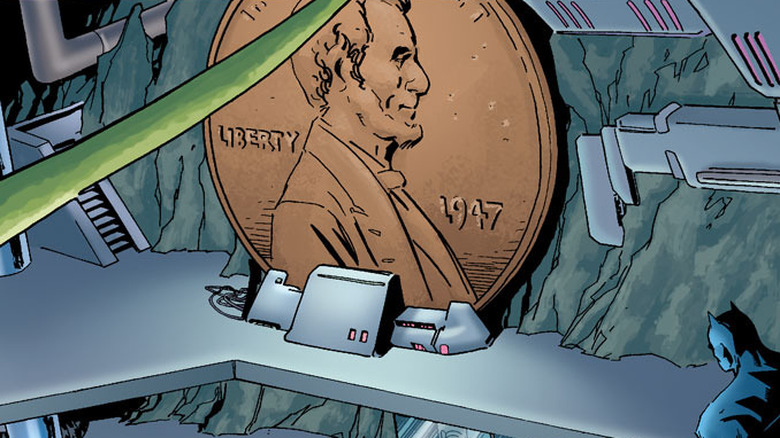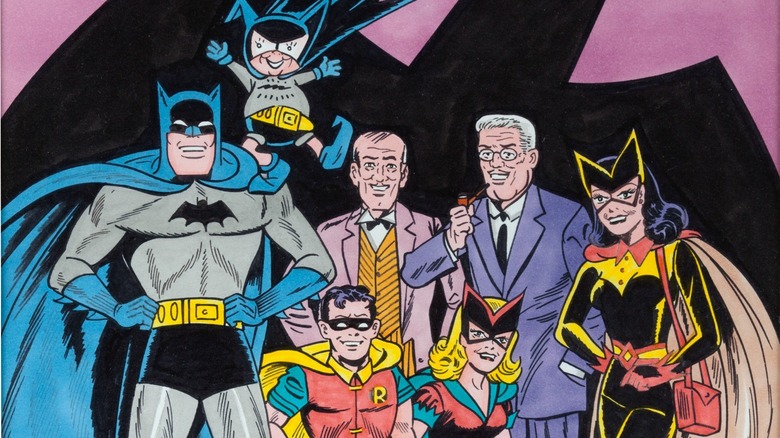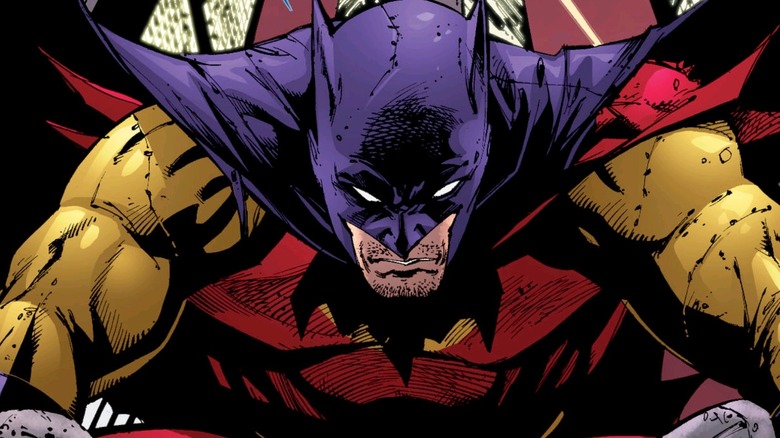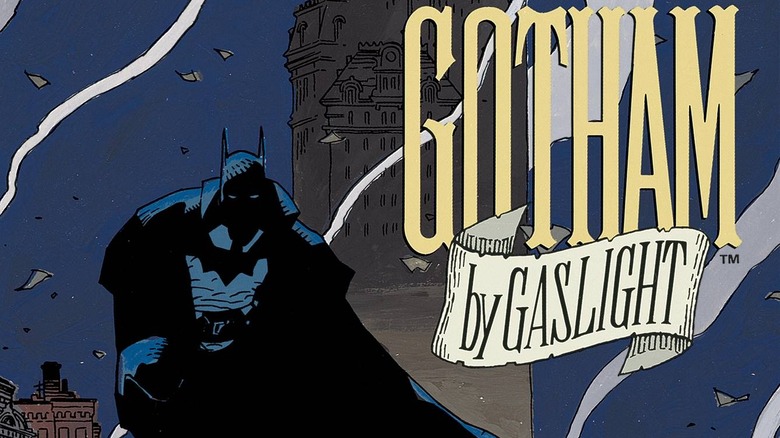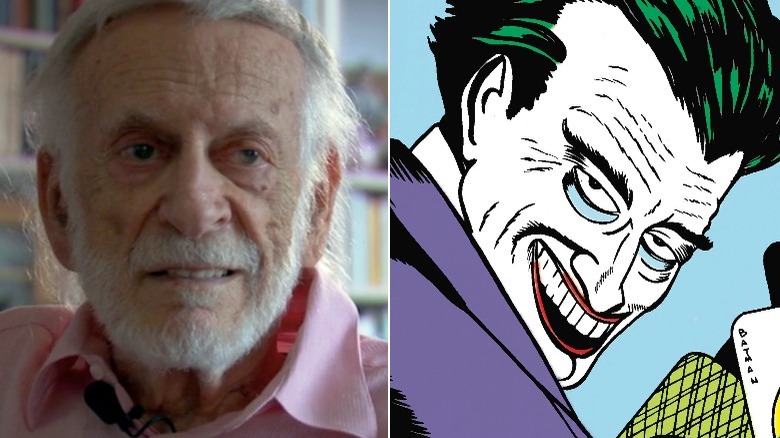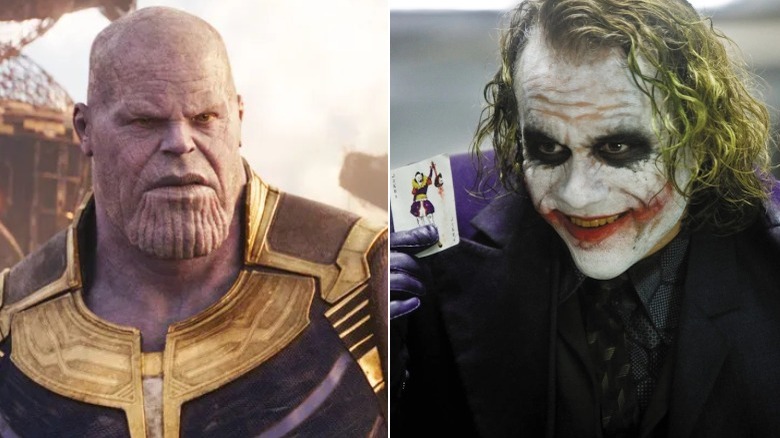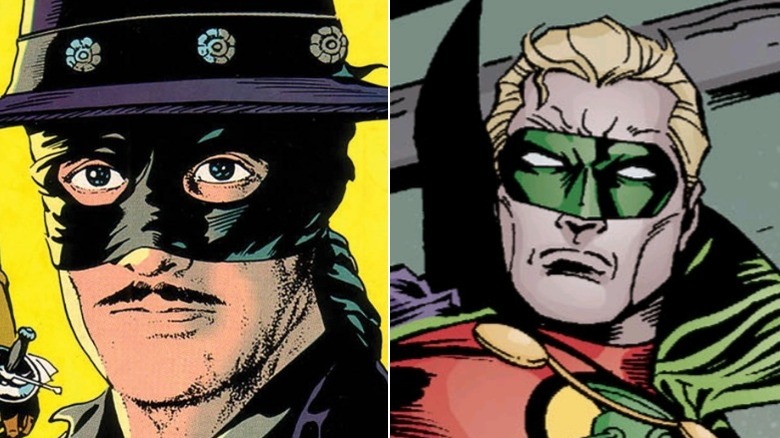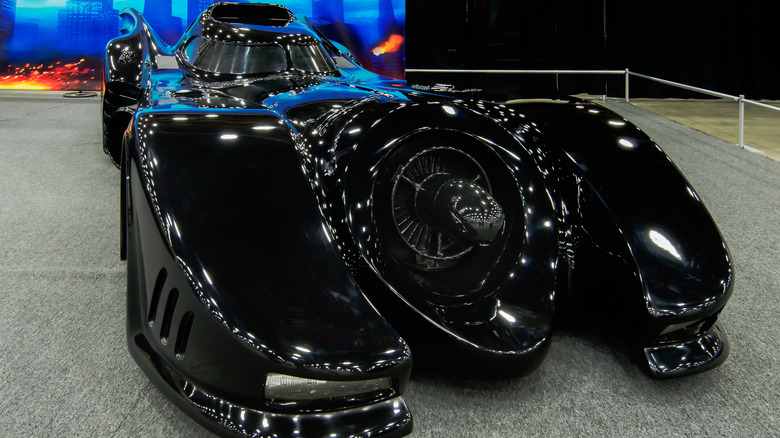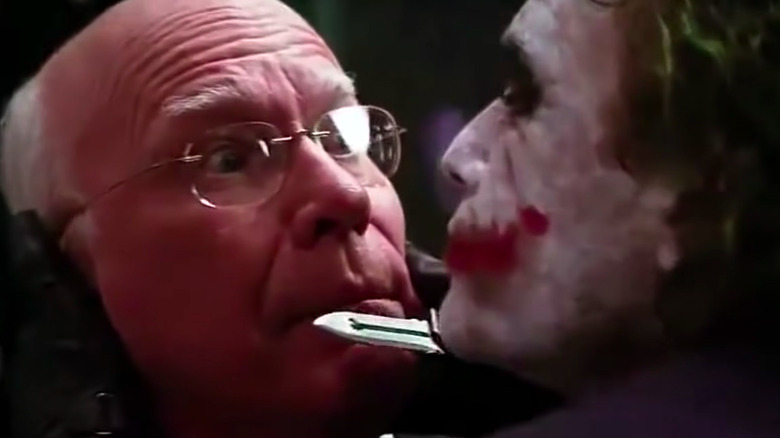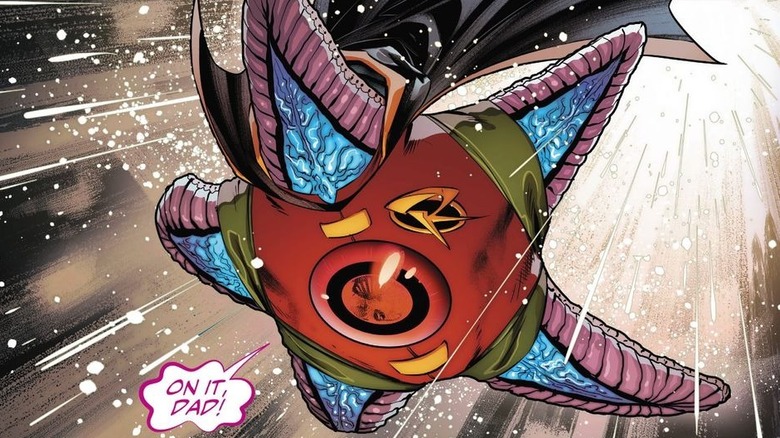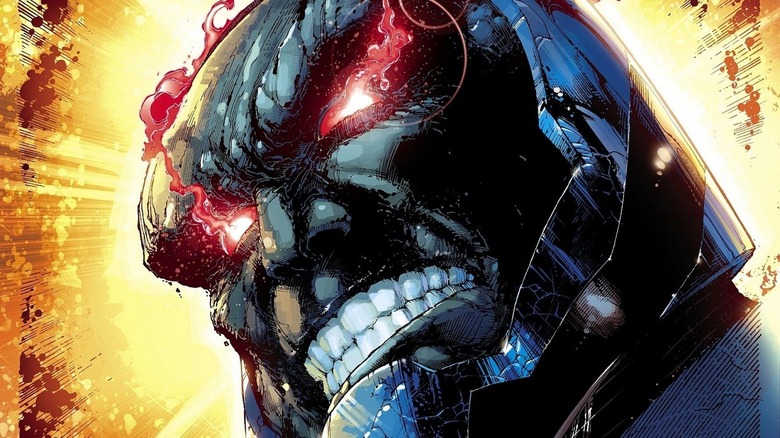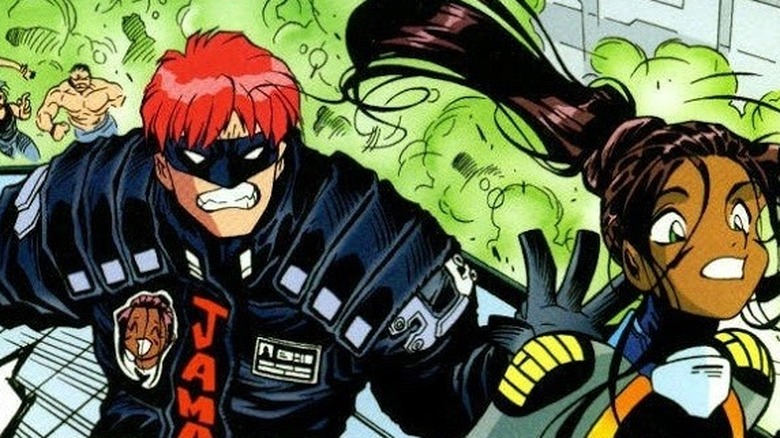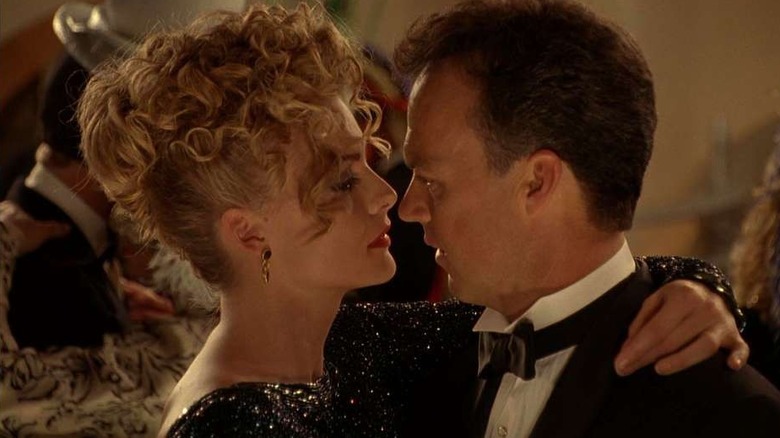The Untold Truth Of Batman
We may receive a commission on purchases made from links.
You'd be hard pressed to find a person who doesn't know about Batman. Since first swinging into action in 1939, the Dark Knight (or Caped Crusader, if you prefer) has gained worldwide recognition, to the point where even those who've never read a Batman comic or seen a TV or movie based on his adventures can identify the character and his iconography (such as the Bat-emblem on his chest) at a glance.
Yet even among the most diehard of Batman fans, there are still some facts about Gotham City's most famous vigilante that might be new to their trained Bat-ears. How much do they know about the character's complicated creation? Or the "wonderful toys" (as Jack Nicholson's Joker aptly puts it in 1989's "Batman" film) he keeps in his cave? And just what led to such a pulp-inspired character having such wacky adventures during DC Comics' Silver Age? Fire up your Bat-Computers as we peel back the mask and unveil a few details about Batman you might not have known about.
His underrated, influential co-creator
The credit line "Batman created by Bob Kane with Bill Finger" marks the long overdue end of the road for the latter creator to get the recognition he's long deserved. As Mark Tyler Nobleman relates in his documentary "Batman & Bill," Finger is the one actually responsible for a lot of things that Bob Kane has been historically credited for. This includes the suggestions that turned Kane's rough red-shirted, barely masked early concept for Batman into the design that ultimately becomes the Dark Knight's first published costume.
Furthermore, a Bill Finger interview conducted by Jerry G. Bails (via Noblemania), the creator of "Alter Ego" magazine, reveals that Finger conceived, co-created or co-developed Batman's allies Alfred and Commissioner Gordon, villains Catwoman and the Joker, and the Dark Knight's faithful sidekick Robin. The last two, however, also owe plenty of credit to co-creator Jerry Robinson, who's not only designed the characters and, as he relates to The Comics Journal, actually came up with the Joker. He also gave the Boy Wonder his superhero name (as he tells Nerd Team 30).
This is not to say Kane didn't have a hand in coming up with some of these concepts, but his contributions are as overstated as Finger's are overlooked.
His early fashion accessory most people don't know about
Ask anyone what colors Batman's costumes tend to be and they'll probably give you familiar answers like black, blue, gray and yellow. What they might not know, however, is that Batman's very first costume also included a color not often associated with his traditional Batsuits: purple. That's right — in addition to being much smaller than they'd later become, Batman's gloves were once the color most identified in his comics with the Joker (and sometimes Catwoman).
As CBR points out, Batman's small, purple gloves are a one-issue wonder, appearing in his debut story in "Detective Comics" #27. The Dark Knight would then leave his hands bare in #28 before very overtly deciding on blue gloves in #29. Since then, it's been mostly black, gray and blue for hand wear, but the purple gloves have returned on a few notable occasions, such as during Scott Snyder and Greg Capullo's "Zero Year" storyline in the 2011 "Batman" comic series (where it forms part of a more makeshift version of Batman's costume) and when a variation of the Golden Age Batman appears in "Detective Comics" #1027, "Generations Shattered" and "Generations Forged."
Batman doesn't kill, except when he does
A surprising debate has raged within the fandom in recent years: Does Batman kill? Some might point to "Batman v Superman: Dawn of Justice," where he clearly does kill a few people; the same holds true in the two Tim Burton-directed Batman movies. Even in Christopher Nolan's "Dark Knight" trilogy, specifically "Batman Begins," he's initially fine with letting his enemies die through other means — even if he refuses to directly kill them.
Hardcore Batman fans, however, will point out that movies aren't the source material. And sure, enough, in the comics, the issue's more complicated. Killing his enemies is certainly something Batman has no problem with in his early appearances, but he moves away from the practice not long after Robin enters the picture. Those early murders are removed from the "main" Batman's history when the Golden Age Batman's retconned into having existed on Earth-Two.
Since then, Batman's been largely against killing, even calling murder "theft of the highest order" in Detective Comics #745. Yet he sometimes still toes the line. He's definitely been responsible for a few deaths in certain runs (though rarely), and even tries killing Ra's Al Ghul in "Batman Annual" #8, though "Batman" #400 proves he fails. He also may have unintentionally killed a few dolphins armed with plastic explosives in "Detective Comics" #405, and has come awfully close to killing the KGBeast, Darkseid and the Joker.
There are real-world Batmen out there
In addition to inspiring cosplayers around the world to don his Bat-likeness, Gotham's Creature of the Night has imitators who've gone as far as to adapt his superhero lifestyle. Canada has Brampton Batman, aka Stephen Lawrence, who spends his evenings helping those in need and even stopping the occasional crime, according to the Brampton Guardian. There's also Alexander Brovedani, alias Toronto Batman. Though largely retired, he still makes the occasional public appearance or funny video (many more of which are on his YouTube page).
Japan, meanwhile, has "Chibatman," the Batman-like hero of the city Chiba. He tells the BBC his goal is to "bring the smiles back" to everyone he meets, ever since the 2011 Great East Japan Earthquake. Dark Knights have been spotted around the U.S. as well, the most endearing perhaps being Batkid, whose famous one day-turn as the Caped Crusader is the subject of the documentary "Batkid Begins: The Wish Heard Around the World."
Sadly, not every Batman has shared Bruce Wayne's long career: the Batman of the U.S. state of Maryland, Lenny B. Robinson (called alternately the "Baltimore Batman" or "Route 29 Batman"), passed away from a traffic accident in 2015 — but he left behind an admirable legacy of brightening children's days whenever he'd set foot in hospitals dressed as Gotham City's most famous defender.
The ever-changing history of the giant penny
You might think the famed giant penny in Batman's cave is a "memento" snagged from Two-Face, given how coins are essential to his decision-making process. In some cases, you'd be right: In post-Crisis continuity, the massive copper coin is revealed to be Two-Face's in "Batman" #410, as well as in "Batman: The Animated Series." Originally, however, the man behind the mammoth penny is the aptly-named Joe Coyne, who debuts in "World's Finest Comics" #30. Years of frustration from constantly trying to amass wealth, yet mainly ending up with pennies, leads Coyne to "coin" himself the Penny Plunderer. He swears revenge on the police who've incarcerated him (a.k.a. "coppers") by dedicating himself to crime, with pennies his motif. Batman and Robin confront the Plunderer at a museum while Coyne and his gang are trying to steal an oversized 1 cent stamp ... and manage to subdue some of the thieves with a giant penny that just so happens to be at the same exhibition. Not long thereafter, that same penny ends up in the cave.
Pretty much every origin since has either involved the Penny Plunderer, Two-Face, or even both characters. Interestingly, the same series that introduces the penny, "World's Finest Comics," actually contradicts its earlier origin for the penny by saying Batman had obtained it while dueling the Joker. Maybe giant pennies aren't hard to come by in Gotham City?
Batman's wackiest years were directly inspired by Superman
Batman is no stranger to outlandish scenarios, having dealt with giant props, time travel via hypnosis and even Martians (but not like the Martian Manhunter) around the mid-to-late 40s. Yet when the 1950s and early '60s roll around, you could say Batman starts feeling a little more ... super. During that decade, Batman's comic book adventures become even more outlandish and a lot more like Superman's, as alien threats, sci-fi gadgets and monsters become far more common. Similarly, Batman's allies, who already include Robin and occasionally Batwoman, expand into a full-on Bat-Family, echoing how a Super-Family forms around Superman during the same time period.
The growing similarities to Superman were far from accidental. As "The Batcave Companion" explains, the DC Comics management at the time (including allegedly chief architect of Superman's Silver Age adventures, Mort Weisinger) pushed Batman editor Jack Schiff into having the Caped Crusader's comics emulate the Man of Steel's, whose comics outsold Batman's by quite a margin. Sadly, that sales gap didn't change when the Batman titles tried things Superman's way, prompting the Dark Knight's adventures to revert to a more successful "back-to-basics" approach with his "new look" revamp in 1964.
The heroes who inspired Batman's weirdest costume
If you've ever looked at Batman's Zur-En-Arrh costume and thought to yourself, "no one on Earth would ever wear something like that" ... well, you're not that far off. Originally, the suit belongs to an alien named Tlano, who becomes the Batman of the planet Zur-En-Arrh after viewing the original Batman's exploits with long-range equipment. Tlano enlists his role model's help in fending off an invasion from another alien world, and Batman is surprised to discover that being on Tlano's planet gives him super-strength, invulnerability and flight. Sound familiar? Small wonder the story, from "Batman" #113, is titled "Batman– The Superman of Planet X!"
During writer Grant Morrison's run on "Batman," the Batman of Zur-En-Arrh is retconned into being Bruce Wayne himself, specifically an alternate persona created to counter mind control. The events of "Batman" #113, consequently, end up being a hallucination induced by Simon Hurt and perhaps even a subconscious desire on Batman's part to have powers like his longtime friend from Krypton. It would also explain why the Zur-En-Arrh costume is so colorful, although Batman overtly seems to attribute that to Robin in "Batman" #680, and it's hard not to note the visual similarities. As for where the name "Zur-En-Arrh" comes from? A misremembered "Zorro in Arkham," which is the end of a sentence Thomas Wayne utters after he, Martha, and Bruce have finished watching "The Mark of Zorro."
He's the star of the first ever Elseworlds series
Many readers of DC Comics during the 1990s may remember Elseworlds, a DC Comics sub-imprint that'd reinterpret DC's characters in various ways. Throughout the decade and into the early 2000s, Elseworlds were a staple of the DC line, with several of the imprint's stories being incorporated into the new DC multiverse birthed from "Infinite Crisis."
The funny thing is that Elseworlds were essentially created by accident, according to writer-editor extraordinaire Brian Augustyn, who wrote the very first one without realizing it at the time: "Batman: Gotham by Gaslight." As he explains in the deluxe edition of the graphic novel, "Gotham by Gaslight" first came about when fellow comics giant Mark Waid suggested an annual of "Secret Origins" creating "alternative histories" of DC favorites — the germ of what Elseworlds would become. "Gotham by Gaslight," however, became a standalone story instead, and years of Elseworlds specials, one-shots and graphic novels in the same vein followed. Interestingly, the first comic to actually (and not retroactively) be called an Elseworlds was not "Gotham by Gaslight," but another Batman story — namely "Batman: Holy Terror," written by another well-known contributor to "Secret Origins," writer Alan Brennert.
Bob Kane's many ghost artists
Grab nearly any Batman issue said to have been made by Bob Kane and chances are that the art you're looking at isn't 100 percent his. Just as Bob Kane took credit that rightfully belonged to Bill Finger, he also had his name published in issues he didn't draw completely, or even at all, as the "Batman & Bill" documentary points out. Instead, a number of ghost artists were responsible for much of Kane's alleged output.
There's the aforementioned Jerry Robinson, who explains to The Comics Journal, "I still finished Bob's drawings for a long time, but I ended up doing my own 'Batman' covers and complete stories on my own." Another famed Kane ghost artist is Dick Sprang, who Alter Ego #19 observes drew the first ever Riddler story. Not as well known but heavily involved in ghosting for Kane is Lew Sayre Schwartz, identified by that same issue of Alter Ego as the illustrator of "Detective Comics" #168, the story which first established the Joker's past as the Red Hood. Other prominent artists who drew under Kane's name are Jim Mooney and Sheldon Moldoff, whose Batman tales number well into the hundreds — not so surprising when you consider Moldoff spent a jaw-dropping 14 years pencilling stories with Kane's signature on them.
The supervillain actors who almost played him
Several big-name actors have at one point or another come close to assuming the role of the Caped Crusader, from Pierce Brosnan to Bill Murray. Interestingly, many of the performers who almost became Batman still ended up appearing in superhero movies ... primarily as villains. Josh Brolin, for instance, told HuffPost that he was considered for the role of the Dark Knight in "Batman v Superman: Dawn of Justice," but instead wound up taking his Marvel Cinematic Universe role as Thanos to great heights; he also became a major Marvel Comics hero, Cable, in "Deadpool 2." Jake Gyllenhaal confirmed to The Daily Beast that he auditioned for Batman for Christopher Nolan's films. Gyllenhaal ended up playing Mysterio in "Spider-Man: Far From Home" and, in fact, nearly replaced an injured Tobey Maguire in "Spider-Man 2."
Funnily enough, there've even been some actors who almost played Batman that instead landed a villain role in the same film. Cillian Murphy, who became the Scarecrow of Christopher Nolan's "Dark Knight" trilogy, recalled to The AV Club (via RTE) that he auditioned for the role of Batman in costume. Heath Ledger, well before signing on as the Joker in "The Dark Knight," said no to the role when Nolan personally offered it to him for "Batman Begins." Amazingly, Ledger's reason — as revealed by Nolan at the Lincoln Film Center in 2012 – was that he "would never take a part in a super hero film." Luckily, his position changed.
Batman's fictional role models
In addition to the many characters that influenced Bill Finger and Bob Kane when creating Batman, the Caped Crusader has in-universe named a couple of heroes who inspired him to give costumed superheroing a try. The most well-known, of course, is Zorro, who is fictional in Bruce Wayne's world, but whose black, caped costume has imprinted itself onto Bruce's mind ever since he saw "The Mark of Zorro" on the night his parents were murdered by Joe Chill. Another major person who has led Bruce to believe the costumed life is right for him is the original Green Lantern, Alan Scott — who not only defended Gotham in the mid-20th century, but has also met Thomas Wayne as a young boy, as revealed in "Detective Comics" #786. Bruce also has a childhood connection to Alan, having once witnessed the Green Lantern evade several blasts from the original Icicle's Cold Gun, as seen in "Batman" #611.
"Batman: The Animated Series" introduces another costumed role model for Bruce Wayne: the Gray Ghost, a fictional TV hero played by Simon Trent ... whose voice actor happens to be a Batman himself, Adam West. Both the Gray Ghost and his alter ego are eventually introduced in the main comics continuity, though not simultaneously: The Gray Ghost debuts in comics with a different man under mask, Clancy Johnson, in 2010's "Batgirl" #9, while Simon Trent makes his first in-continuity appearance in "Gotham Academy" #4, during DC's "New 52" era.
The Batmobiles you could have owned
Three separate contests have made owning the Batmobile a dream come true for certain Batmaniacs ... sort of. The first was held by the San Francisco Chronicle to promote its debut of the 1966 Batman comic strip a mere four months after January's monumentally-popular "Batman" series began airing on ABC. As the fine print revealed, however, the Batmobile being offered wasn't nearly as spectacular as the show's, even jestingly calling it a "magnificent monstrosity." That didn't stop winner Richard Morse, however, who told the Chronicle 55 years later he drove the dubious facsimile in the San Mateo's Fourth of July parade while in a Robin costume, with Batman and George Washington — or rather, his brothers Rich and Doug — as his passengers.
That Batmobile, at least, could be driven, unlike the one MTV gave away in 1989 for its "Steal the Batmobile" contest. Though identical to Michael Keaton's ride from "Batman," the car was engineless and a major tax burden for its winner, Patrick McLynn, as Richmond Magazine reports ... though McLynn did get $25,000 and the chance to meet Robert Wuhl (Alexander Knox) in the process. A third Batmobile was offered, this time by Taco Bell, in 1997's "Unmask Batman" contest to promote "Batman & Robin," but it also had a catch: The vehicle, as its commercial notes, was "not approved for use on public roads." Although it likely inspired the Drew Carey episode "Batmobile," where Drew wins the "Batman Forever" Batmobile in a similar giveaway.
The real-life politician who keeps showing up in Batman movies
Not every government official in Gotham City likes Batman, but he's got himself at least one major real life politician on his side: U.S. Senator Patrick Leahy of Vermont, a longtime Bat-fan. As Insider notes, he has been in nearly every Batman movie from "Batman Forever" up to "Batman v Superman: Dawn of Justice," skipping only "Batman Begins." He's even lent a voice to "Batman: The Animated Series," as the Governor. Leahy sat out "The Batman," however — much as he'd like to take part, he explained to the Burlington Free Press that his present workload as Senator (not to mention a global pandemic) is keeping him from making his customary trips to Gotham this time around.
In addition to joining Batman on the silver screen, Leahy has added his own dab of ink to Batman's comic book adventures, with both "Detective Comics: 80 Years of Batman (Deluxe Edition)" and "Batman: Death of Innocents: The Horror of Landmines" bearing text pieces written by the Senator. As Leahy told The Washington Post, the latter comic — which the Vermont politician gave to the entire Senate — may have actually been instrumental in getting his historic anti-landmine legislation passed.
His sidekicks can get gloriously weird
Most of Batman's partners in crimefighting are pretty conventional, as far as sidekicks go. Naturally, there are the many Robins who've worked for him over the years, some of whom have graduated to new identities like Nightwing and Red Robin. There have also been multiple Batgirls, along with unique junior heroes like Bluebird and the Signal.
There are some pretty strange outliers, however. One such example is Jarro, a tiny leftover piece of Starro the Conqueror that Batman takes in as his own and places in a jar in his cave (hence his name). The diminutive starfish views Batman as a father and dreams of becoming his next crimefighting partner, even donning a small Robin costume at one point and holding his own against the Legion of Doom. He also happens to be the strongest psychic the DC Universe has to offer. Batman's sidekicks get even odder once you venture outside of continuity: The "Bizarro World" graphic novel, for instance, introduces Monkey the Monkey Wonder, a circus monkey Batman whom adopts and tries to induct into the crimefighting life ... to less than stellar results.
His unusual history with Darkseid
DC's heroes have often been compared to mythological characters, with Batman being frequently equated to Hades or Pluto. So it's perhaps natural that he has particularly unique interactions with Darkseid, the New God of the fiery planet Apokolips. In "Superman/Batman" #12, for instance, Batman earns the cruel god's respect by threatening to create hundreds of new fire pits across the planet (likely destroying it) unless Darkseid releases his hold on Supergirl. The two face off again during "Final Crisis," when Batman fires a bullet at him made of Radion; Darkseid retaliates by sending Batman back in time with his Omega Beams, simultaneously turning the Dark Knight into a "bomb" against time.
There have been times where Batman has also served Darkseid, albeit not always loyally. When the Justice League accidentally hands Earth to Darkseid on a platter by destroying the Philosopher's Stone in the "JLA" story "Rock of Ages," Batman gains the New God's trust by posing as the infamous Apokoliptan torturer Desaad — abandoning the ruse when the Flash, Green Lantern, and Aquaman from 15 years earlier arrive. The storyline likely influenced Batman's role in "Justice League Dark: Apokolips War," which is set in a future where Darkseid's also conquered Earth and the Dark Knight serves him willingly, having been brainwashed. Rather than disguising himself as one of Darkseid's traditional servants, Batman performs his duties as himself, albeit connected to Metron's Mobius Chair — a nod to another comic book saga, "The Darkseid War."
Bruce Wayne: Teen Titan?
Bruce Wayne officially begins his crusade as Batman as an early adult, meaning he never spends time as a teen superhero ... in the modern day, that is. Yet in the Elseworlds story "Titans: Scissors, Paper, Stone," Jamadagni Renuka (a teenage "Nietzschean genemage" seeking to recreate the Teen Titans on an archetypal level) attaches a device to her ex-boyfriend Alec Swanwick's neck. This device downloads Batman's personality into his mind. While he's never outright confirmed to be the original Dark Knight, the mentally transformed Alec's demeanor, gruff voice and deductive skills — along with his immediate realization that he's filling the role his first Robin, Dick Grayson, did on the Titans — makes it pretty clear he's meant to be the Batman himself. In the story, he's given a different codename — "Captain Thug" — while Jamadagni and her friends are christened names like "Witchy-Poo" and "Prosthetic Lass," which are subtle references to Teen Titans like Raven and Cyborg.
That said, in the main DCU canon, multiple Teen Titans have actually been Batman. During "Battle for the Cowl," ex-Titans (and former Robins) Jason Todd and Tim Drake briefly assume the Batman identity. Dick Grayson, the Titans' original leader, has been Batman in both the 1990s "Prodigal" storyline and after Darkseid sends Bruce Wayne back in time. The Titans/Robins have also been Batman in a number of alternate realities, with Tim even becoming Batman Beyond.
The masquerade balls that changed his life
While wearing a costume is literally a major part of what being Batman's all about, one wouldn't expect Bruce Wayne at a masquerade ball dressed as his alter ego. Yet amazingly, two such balls hugely impacted him in the comics. The first is a costume party held in his youth, in which his father wears a Bat-themed disguise and is even referred to as a "Bat-Man" when he wins the prize for best costume. Clearly, the get-up leaves its impact on Bruce, as he himself admits in "Detective Comics" #235. In pre-Crisis continuity, Batman even puts on the outfit himself to scare mobster Lew Moxon. Simon Hurt also wears the costume as part of his ploy to convince Batman that Hurt is Thomas and somehow survived Joe Chill's attack.
The other masquerade ball that leaves a mark on Bruce is the one where Barbara Gordon debuts as Batgirl, in the classic "Detective Comics" #359. Funnily enough, one of the biggest scenes in the film "Batman Returns" is also at a masquerade ball, in which Bruce Wayne and Selina Kyle learn each other's costumed identities and the Penguin abducts his former associate, Max Shreck.
